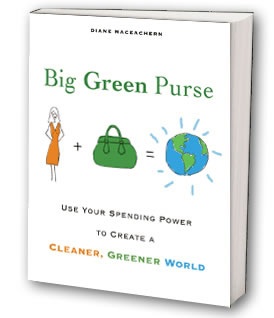Interview with Big Green Purse Author Diane MacEachern
If you’re anything like me, your list of “must read” books is longer than your list of “recently read” books! Prior to interviewing Diane MacEachern, author of the new eco-handbook Big Green Purse, I admitted that I might not make it through the entire book prior to speaking with her.
As the author confessed to OrganicMania, “None of us have any time! It’s hard to concentrate and read. The book is intentionally designed so that if don’t need to read the whole book, you can just check out the sections of interest to you.”
Imagine my surprise when a week or so later I had read a great deal of the book, which aims to inspire women to use their collective purchasing power to “create a cleaner, greener world.” Easy-to-read, informative, I could go on and on…but check out this review from EnviroMom.
Following is Part I of OrganicMania’s interview with Diane MacEachern. Check here for Part II.
OrganicMania: Some pundits dismiss women’s interest in the environment as just a passing fad. You’ve been writing about the environment for nearly 30 years now, so you’ve seen interest come and go. Do you think this latest upsurge in interest is a reflective of a real change in people’s priorities, or just the latest cool trend?
Diane MacEachern: I’m very optimistic. We suddenly realize how serious these environmental problems are. I don’t think this is just a trend because we are becoming so educated about the relationship between the environment and human health. It’s not just buying cool organic tee shirts, but it’s women recognizing that they need to buy products without phthalates so that my unborn baby has a healthy life and deodorant without parabens so I don’t get breast cancer. And this only will get stronger as more and more research goes down this path.
Another big issue is air pollution. Women suffer more heart attacks than men because our blood vessels are smaller. We’re more severely impacted by poor air quality. Our children are also suffering from more cases of asthmas because of environmental issues. The only way that will change is to protect the environment, or else we’ll have more heart attacks, more asthma, and more health consequences to every environmental problem that we’re looking at.
OrganicMania: There’s also a perception that this rising green consciousness is a very upper-middle-class phenomenon. There was a lot of sniping about that in the blog chatter about The New York Times article on Eco-moms. I was pleased to see your book included money saving tips, making it seem very accessible, like it was written for Everywoman. Do you see women from all walks of life embracing the green movement? Do you think this is a real shift that will embrace all women?
Diane MacEachern: I’ve been to a lot of bookstores for book readings, and my observation is that there are definitely people there who are interested in this topic who come from all economic levels. There are a lot of upper middle class women who will ask indignantly, “Isn’t this just for wealthy women?” I have two responses to that.
Everybody can do something. You can turn off your lights. Everybody can afford 99 cents for a reusable shopping bag. Anyone can shop at thrift stores. It’s fabulous. We need to dismiss this notion that eco-consciousness is only for wealthy people. Environmental degradation doesn’t affect only wealthy people.
But those who are wealthy do have a responsibility to be to be leaders and early adopters to protect the environment. They can ultimately help to drive down price if they buy these green products until supply and demand really kicks in, and prices decrease. I remember when I bought my first compact fluorescent bulb. It was $25. Today you can buy them for $1.99. I’m proud to be an early adopter, a woman who uses money to make a difference. That’s a really important part of the book.
OrganicMania: Big Green Purse talks quite a bit about the connection between phthalates and early onset puberty, but you don’t write about a possible connection between early onset puberty and hormones in milk. Many people use that possible link as a reason for buying organic milk. Do you disbelieve that?
Diane MacEachern: I didn’t have time to do all the research into the consequences of hormones and milk. I’m going to put that information on the Big Green Purse website, along with information about hormones in meat. The website will constantly refresh the book.
Go here to read Part II of this interview.
Copyright 2008 OrganicMania
Filed under Green Ideas & Stuff, Interviews, Organic Mommypreneurs, Organics, Pregnancy | Wordpress Comments (3) |Friday Savings Tip: Organic Coupons
Remember the coupons that Mom clipped? They still come in the Sunday paper, but typically they’re for unhealthy processed foods and toxic cleaning products. Finding savings on green and organic products can be a challenge, which is why OrganicMania is posting about savings on Fridays, before most of us head out to do our weekend grocery shopping.
Do you know about Mambo Sprouts coupons? Through these coupon books, you can grab savings of 50 cents to $1.00 off popular organic items including Organic Valley milk, Ian’s™, Kashi™ cereal, Oregon chai, BACK to NATURE granola, and more.
They’re available in most organic grocery stores, but unfortunately some stock them at the check-out register. This makes no sense! You’ve already done your shopping by that point! If you’d like to plan your shopping trip before you reach the check-out, you can find the organic coupons online here.
Happy Shopping!
Lynn
Copyright 2008 OrganicMania
Filed under Coupons, Food, Green Ideas & Stuff, Organic Prices, Organics, Savings Tips | Wordpress Comments (5) |You Read it Here First: School Lunch Controversy on TV
This post about school lunch attracted the attention of a TV reporter, who came out to interview OrganicMania about the state of school lunches. You can see the results here. (Just go to the segment filmed on 8 April, 16:05 minute mark.)
At the close, the reporter notes that school officials said they will not introduce organic food because of the expense.
I don’t know of a single parent who approves of the school lunch program. Why won’t school officials consider creative ways to improve school lunch, rather than dismissing suggestions because of cost?
Here are some ideas:
– What about getting “Big Organics” companies to subsidize organic milk? Other companies subsidize their products in an effort to target a growing market, so why not engage the dairies in an attempt to get hormone-free milk in the schools?
– How about charging a subsidy on top of the organic lunch to subsidize the Free and Reduced Price Lunch Program? Parents who disapprove of the nutritional content in school lunch are already paying a premium to make lunch at home. The school system could use its purchasing power to negotiate discounts on higher quality ingredients that would match what parents are making at home. Not only would parents pay less, but they would gladly save themselves the time and trouble of making lunch at home if their children were assured of healthy, nutritious, fresh meals with organic ingredients where they count most (the Environmental Working Group’s “Dirty Dozen” plus milk and carrots would be a great start!)
– What about rallying behind the innovative “Farm to School” program, which connects schools with local farms to deliver farm-fresh food to the public schools?
If you live in Montgomery County, Maryland and would like to learn more about nutrition in the schools, please attend a Montgomery County Council of PTAs meeting on nutrition and physical activity, to be held April 22nd from 7 pm to 8 pm in the auditorium at the Carver Educational Services Center, 850 Hungerford Drive, Rockville. Kathy Lazor, MCPS Director of Food and Nutrition Services, will talk about nutrition issues and MCPS initiatives. (She is the official interviewed in the TV segment).
OrganicMania will report on this meeting, because the issues discussed there will be relevant not only to Montgomery County, but also to parents facing these issues in their local schools.
What do you think of school lunch? Please leave a comment and share!
And for more info, check out these older OrganicMania posts here, here and here and this great post from Expatriate’s Kitchen.
(And speaking of Expat, she’s running a great carnival at Eat.Drink.Better).
— Lynn
Copyright OrganicMania 2008
Filed under Food, Organic Prices, Organic Product Needs, Parenting, School lunches | Wordpress Comments (5) |How to Find Safe Fish On-the-Go
Did you know that now you can get information about safe fish while in the fish market? Just point your mobile browser to m.edf.org/seafood.
Launched last month by the good folks at the Environmental Defense Fund, this quick mobile reference guide breaks fish into three easy categories: Eco-Best, Eco-Okay, and Eco-Worst. It also provides recommendations for more than 200 types of seafood. You can even access the latest health alerts. I checked this out with my Treo and it sure works for me!
And now that you know how to find safe fish, if you’re wondering where to find it an affordable price, check out this post.
— Lynn
Filed under Food | Wordpress Comment (1) |Not a Fish Tale: Save Big on Wild Alaskan Sockeye Salmon
Nutritionists recommend 2 to 3 servings of eco-safe fish per week. Figuring out which fish is safe to eat used to be a major challenge. Thanks to guides such as this one from the Environmental Defense Fund, that’s no longer an issue. And “organic” fish? Don’t bother.
But with prices through the roof, finding affordable fish is an issue. I nearly fainted when I saw previously frozen wild king salmon for $21.99 per pound at Whole Foods.
There’s a well-kept secret at Whole Foods that can save you a lot of money. Skip the fresh fish counter, and check out the section where pre-packaged frozen fish is kept. There you’ll find Whole Foods’ house brand, Whole Catch. Instead of paying $16.49 for 12 ounces of previously frozen wild sockeye salmon, you can purchase Whole Catch frozen wild Alaskan sockeye salmon for $7.99, a savings of $8.50! That’s not pocket change, particularly if you’re trying to incorporate fish into your diet on a regular basis.
True, it does take some pre-planning to defrost the fish overnight. But that’s a trade-off worth $8.50 per meal. And if you’re in a hurry, you can always defrost it in the microwave.
Another tip? If you live in an area where fish prices are sky high, consider bringing a cooler and stocking up on fish when you’re at the beach this spring and summer. Prices generally are lower there, and sometimes you can even find good deals on great fish at the supermarket. But remember to check with the local fisheries council if you’re going out-of-town and are unfamiliar with the local fish. Sadly, there are more contamination warnings out than ever before due to environmental irresponsibility, so you need to be careful, particularly if you are feeding children or pregnant women.
Looking for more savings before hitting the grocery stores this weekend? Check out Money Saving Mom and The Bargain Shopper Lady.
— Lynn
Copyright 2008 OrganicMania
Filed under Food, Organics, Organics vs. Conventional Foods, Savings Tips, Whole Foods | Wordpress Comments (7) |Green Savings Tip for School Lunch
When it comes to school lunches, finding healthy, organic foods that won’t break the bank and that are packaged sustainably can be quite a chore.
Juice packs are all the rage with kids. But did you ever look at the pile of juice boxes and plastic straws left over after lunch? What a waste of packaging and natural resources! Not to mention the expense of those little boxes! They’re certainly not cheap.
It’s not a good idea to save money by compromising on non-organic juice, particularly if it’s apple juice your child is drinking. Apples are heavily laden with pesticides, and childrens’ bodies are very sensitive to the chemical load of pesticides.
What to do? You can save money and reduce waste by purchasing a large container of organic apple juice and a re-usable juice box or thermos. Plus, you can dilute the apple juice with water to make it an even healthier treat for your child. Diluting with water also makes that large bottle last longer, making it less expensive. Works for me!
And just to make it even easier for you….here’s a link to a printable coupon for 75 cents off a large bottle of Santa Cruz organic juice. If there’s a Whole Foods near you, check out their house brand of 365 Organics – they’re considerably cheaper than the name brands, although with this Santa Cruz coupon, you’ll need to compare prices at your local store.
— Lynn
Copyright OrganicMania 2008
Filed under Food, Green Ideas & Stuff, Organic Prices, Organics vs. Conventional Foods, Parenting, Product Recommendations, School lunches, Sustainable Packaging, Tips, Where to Buy Organics | Wordpress Comments (7) |McDonalds on Eco-Friendly Happy Meals
Every parent knows that being stuck on the road with a hungry kid is a dilemma. It’s so hard to find healthy fare on the road that even some Green Eco-Moms find themselves in McDonalds. More importantly, most American kids eat at McDonalds. Think of the huge environmental impact McDonalds could make by greening the Happy Meal and replacing the Cheap Plastic Crap Happy Meal toys with an eco-friendly alternative toy!
The Wall Street Journal recently published a report about McDonalds Corporate Sustainability Blog. I wasn’t familiar with McDonalds environmental initiatives, so I checked out their blog, and left a comment suggesting McDonalds could do even more for the environment by introducing organic Happy Meal selections and eco-friendly Happy Meal toys.
Take a look at McDonalds response via this link. And let me know what you think by leaving a comment below!
And by the way, their response came 13 days after I left the comment! (The date doesn’t show up on their blog, but I have it via email).
— Lynn
Copyright 2008 OrganicMania
Filed under Cheap Plastic Crap, Eco-friendly toys, Food, Green Ideas & Stuff, Marketing, Organic Product Needs, Organic Restaurants, Parenting | Wordpress Comments (6) |


 My StumbleUpon Page
My StumbleUpon Page



